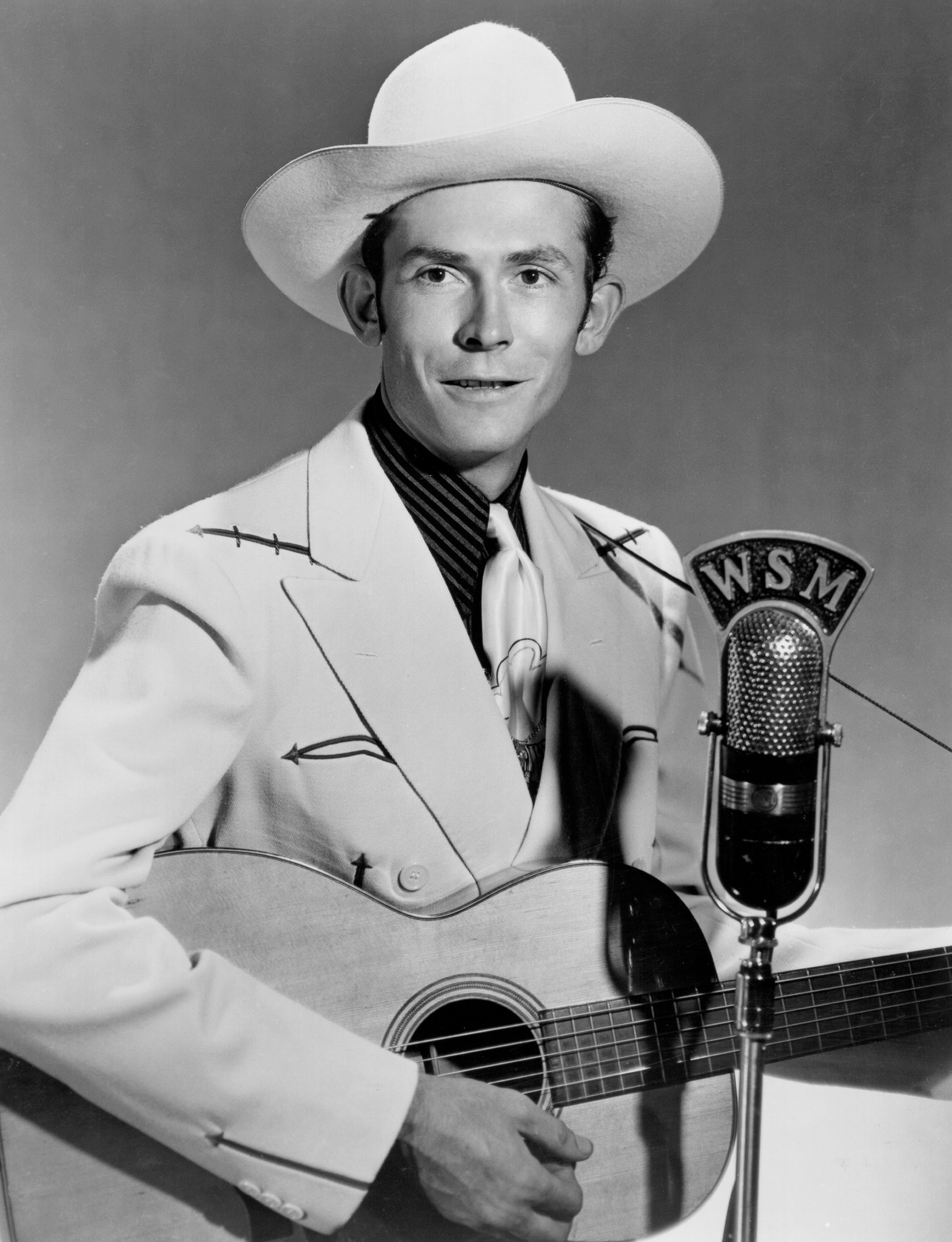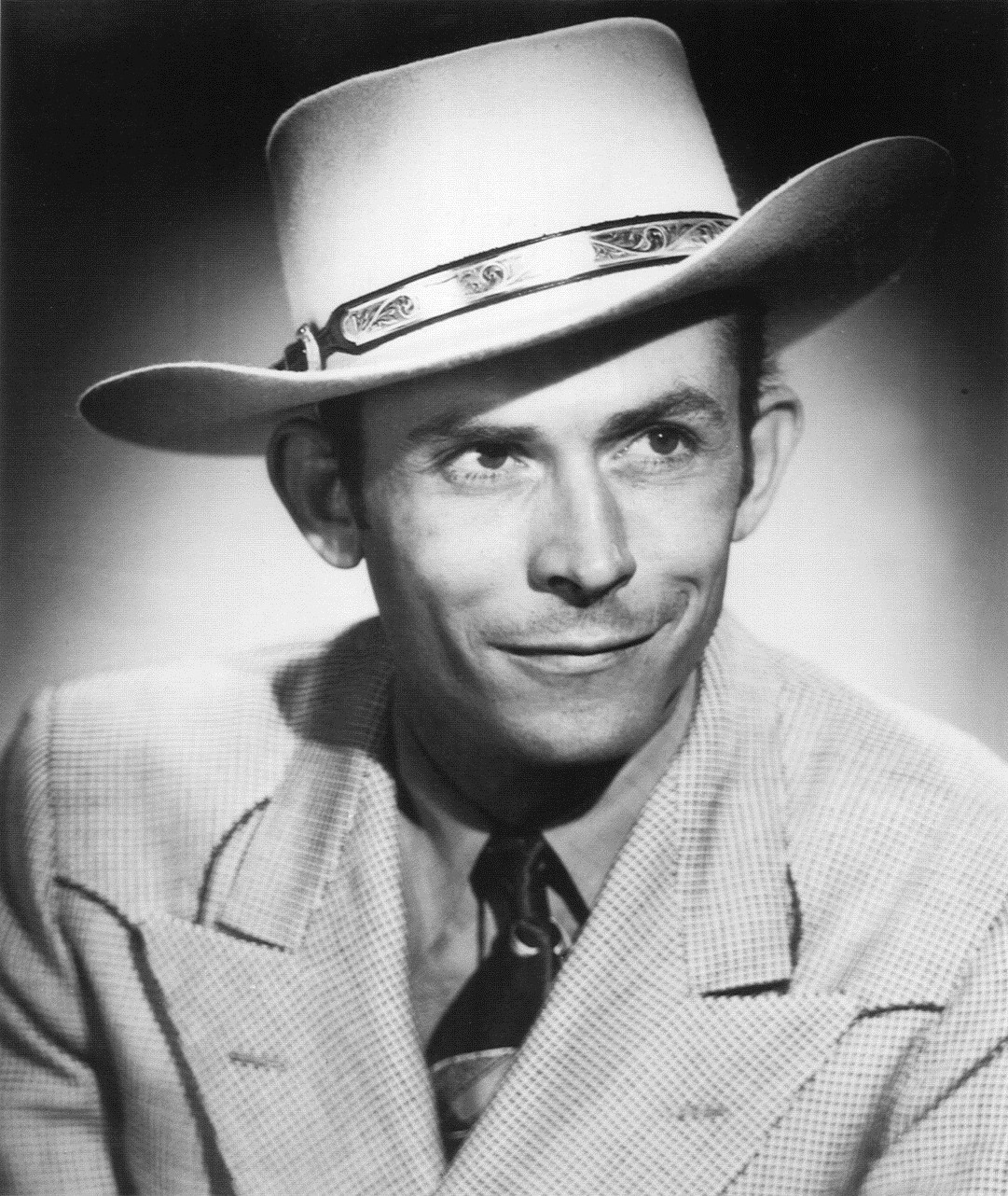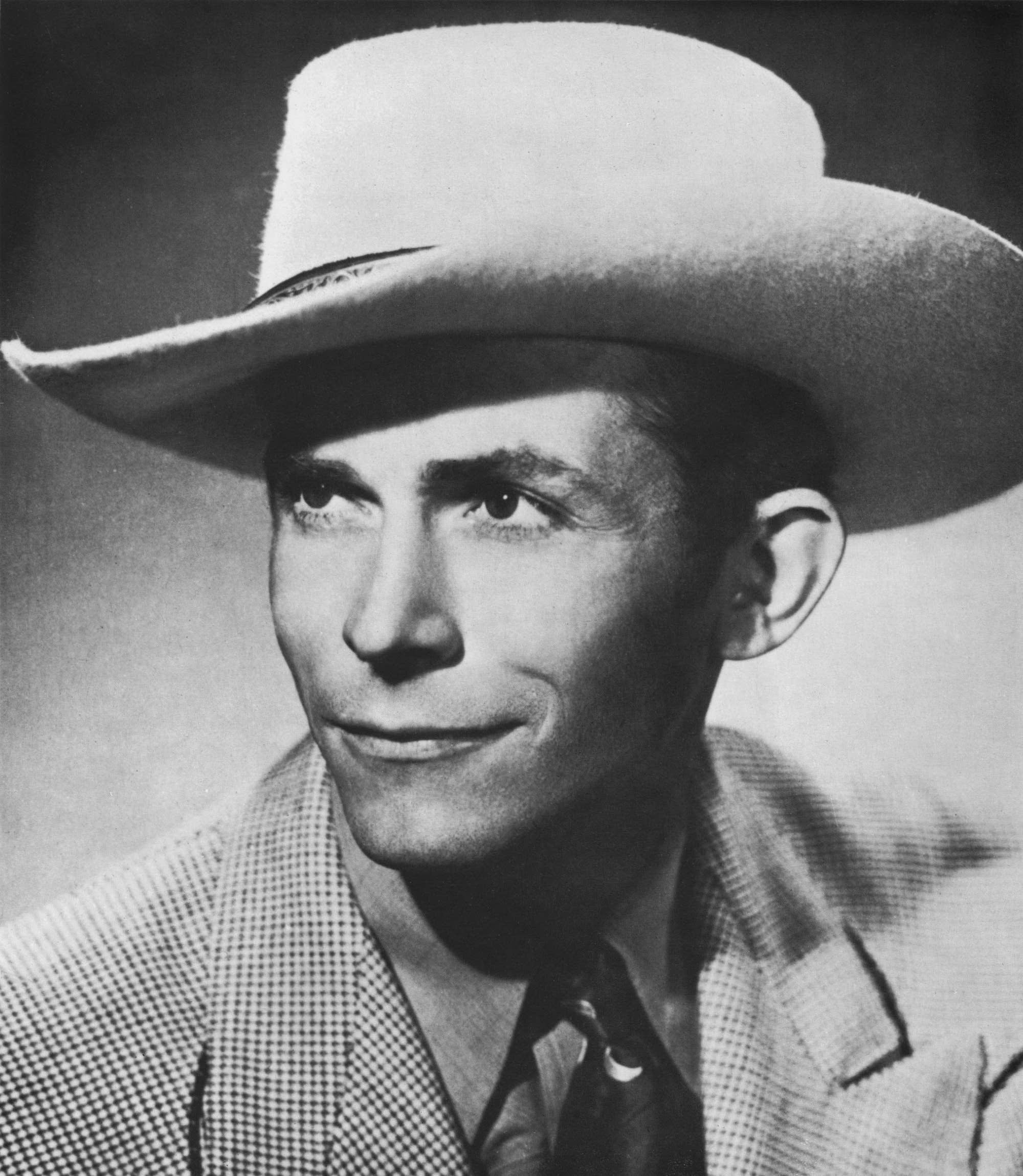The popular song "My Bucket's Got a Hole in It" became a hit for Hank Williams in 1949.
Problems playing this file? See media help.
There are several versions of how Williams got his first guitar. His mother stated that she bought it with money from selling peanuts, but many other prominent residents of the town claimed to have been the one who purchased the guitar for him. While living in Georgiana, Williams met Rufus "Tee-Tot" Payne, a street performer. Payne gave Williams guitar lessons in exchange for money or meals prepared by Lillie.[24][25] Payne's base musical style was blues.[26] Payne taught Williams chords, chord progressions, bass turns, and the musical style of accompaniment that he would use in most of his future songwriting. Later on, Williams recorded "My Bucket's Got a Hole in It", one of the songs that Payne taught him.[27] His musical style contained influences from Payne along with several other country influences, among them Jimmie Rodgers, Moon Mullican, and Roy Acuff.[28] In 1937, Williams got into a fight with his physical education teacher about exercises the coach wanted him to do. His mother subsequently demanded that the school board terminate the coach; when they refused, the family moved to Montgomery, Alabama. Payne and Williams lost touch, though Payne also eventually moved to Montgomery, where he died in poverty in 1939. Williams later credited him as his only teacher.[29]
Career - 1930s
Williams performing in Montgomery in 1938
In July 1937, the Williams and McNeils opened a boarding house on South Perry Street in downtown Montgomery. It was at this time that Williams decided to change his name informally from Hiram to Hank. Williams told a story in later concerts that attributed his name change to a cat's yowling. The authors of Hank Williams: The Biography pointed out that "Hank" sounded more "like a hillbilly and western star" than "Hiram".[30] During the same year, he participated in a talent show at the Empire Theater. He won the first prize of $15, singing his first original song "WPA Blues". Williams wrote the lyrics and used the tune of Riley Puckett's "Dissatisfied".[31]
He never learned to read music; instead he based his compositions in storytelling and personal experience.[32] After school and on weekends, Williams sang and played his Silvertone guitar on the sidewalk in front of the WSFA radio studio.
His recent win at the Empire Theater and the street performances caught the attention of WSFA producers who occasionally invited him to perform on air. So many listeners contacted the radio station asking for more of "the singing kid", possibly influenced by his mother, that the producers hired him to host his own 15-minute show twice a week for a weekly salary of US$15 (equivalent to $300 in 2021).
In August 1938, Elonzo Williams was temporarily released from the hospital. He showed up unannounced at the family's home in Montgomery. Lillie was unwilling to let him reclaim his position as the head of the household. Elonzo stayed to celebrate his son's birthday in September before he returned to the medical center in Louisiana. Williams's mother had claimed that he was dead.[33]
Williams's successful radio show fueled his entry into a music career. His salary was enough for him to start his own band, which he dubbed the Drifting Cowboys. The original members were guitarist Braxton Schuffert, fiddler Freddie Beach, and comedian Smith "Hezzy" Adair. James E. (Jimmy) Porter was the youngest, being only 13 when he started playing steel guitar for Williams. Arthur Whiting was also a guitarist for the Drifting Cowboys.[36] The band traveled throughout central and southern Alabama performing in clubs and at private gatherings. James Ellis Garner later played fiddle for him. Lillie Williams became the Drifting Cowboys' manager. Williams dropped out of school in October 1939 so that he and the Drifting Cowboys could work full-time.[15] Lillie Williams began booking show dates, negotiating prices and driving them to some of their shows. Now free to travel without Williams's schooling taking precedence, the band could tour as far away as western Georgia and the Florida Panhandle.[37] The band started playing in theaters before the start of the movies and later in honky-tonks.[38] Williams's alcohol use started to become a problem during the tours; on occasion he spent a large part of the show revenues on alcohol. Meanwhile, between tour schedules, Williams returned to Montgomery to host his radio show.
1940s
Williams, Sheppard, and the Drifting Cowboys band in 1951
The American entry into World War II in 1941 marked the beginning of hard times for Williams. While he was medically disqualified from military service after suffering a back injury caused by falling from a bull during a rodeo in Texas, his band members were all drafted to serve. Many of their replacements refused to play in the band due to Williams's worsening alcoholism. He continued to show up for his radio show intoxicated, so in August 1942 the WSFA radio station fired him for "habitual drunkenness". During one of his concerts, Williams met his idol, Grand Ole Opry star Roy Acuff backstage, Who later warned him of the dangers of alcohol, saying, "You've got a million-dollar talent, son, but a ten-cent brain."
He worked for the rest of the war for a shipbuilding company in Mobile, Alabama, as well as singing in bars for soldiers.[31] In 1943, Williams met Audrey Sheppard at a medicine show in Banks, Alabama. Williams and Sheppard lived and worked together in Mobile.[43] Sheppard later told Williams that she wanted to move to Montgomery with him and start a band together and help him regain his radio show. The couple were married in 1944 at a Texaco Station in Andalusia, Alabama, by a justice of the peace. The marriage was declared illegal, since Sheppard's divorce from her previous husband did not comply with the legally required 60-day trial reconciliation.[44][45]
In 1945, when he was back in Montgomery, Williams started to perform again for the WSFA radio station. He wrote songs weekly to perform during the shows.[46] As a result of the new variety of his repertoire, Williams published his first songbook, Original Songs of Hank Williams.[41] The book only listed lyrics, since its main purpose was to attract more audiences, though it is also possible that he did not want to pay for transcribing the notes. It included 10 songs: "Mother Is Gone", "Won't You Please Come Back", "My Darling Baby Girl" (with Audrey Sheppard), "Grandad's Musket", "I Just Wish I Could Forget", "Let's Turn Back the Years", "Honkey-Tonkey", "I Loved No One But You", "A Tramp on the Street", and "You'll Love Me Again".[47] With Williams beginning to be recognized as a songwriter,[48] Sheppard became his manager and occasionally accompanied him on duets in some of his live concerts.[49]
On September 14, 1946, Williams auditioned for Nashville's Grand Ole Opry, but was rejected. After the failure of his audition, Williams and Audrey Sheppard attempted to interest the recently formed music publishing firm Acuff-Rose Music. Williams and his wife approached Fred Rose, the president of the company, during one of his habitual ping-pong games at WSM radio studios. Audrey Williams asked Rose if her husband could sing a song for him on that moment,[50] Rose agreed, and he liked Williams's musical style.[51] Rose signed Williams to a six-song contract, and leveraged this deal to sign Williams with Sterling Records. On December 11, 1946, in his first recording session, he recorded "Wealth Won't Save Your Soul", "Calling You", "Never Again (Will I Knock on Your Door)", and "When God Comes and Gathers His Jewels", which was misprinted as "When God Comes and Fathers His Jewels".[41] The recordings "Never Again" and "Honky Tonkin'" became successful, and earned Williams the attention of MGM Records.[52]
Lovesick Blues
0:14
A major hit for Hank Williams, "Lovesick Blues" moved him to the mainstream of country music and assured him a position in the Grand Ole Opry.
Problems playing this file? See media help.
Williams signed with MGM Records in 1947 and released "Move It on Over"; considered an early example of rock and roll music, the song became a massive country hit. In 1948, he moved to Shreveport, Louisiana, and he joined the Louisiana Hayride, a radio show broadcast that propelled him into living rooms all over the Southeast appearing on weekend shows. Williams eventually started to host a show on KWKH and started touring across western Louisiana and eastern Texas, always returning on Saturdays for the weekly broadcast of the Hayride.[53] After a few more moderate hits, in 1949 he released his version of the 1922 Cliff Friend and Irving Mills song "Lovesick Blues",[54] made popular by Rex Griffin. Williams's version became a huge country hit; the song stayed at number one on the Billboard charts for four consecutive months,[55] crossing over to mainstream audiences and gaining Williams a place in the Grand Ole Opry.[56] On June 11, 1949, Williams made his debut at the Grand Ole Opry, where he became the first performer to receive six encores.[57] He brought together Bob McNett (guitar), Hillous Butrum (bass), Jerry Rivers (fiddle) and Don Helms (steel guitar) to form the most famous version of the Drifting Cowboys, earning an estimated $1,000 per show (equivalent to $11,400 in 2021) That year Audrey Williams gave birth to Randall Hank Williams (Hank Williams Jr.).[58] During 1949, he joined the first European tour of the Grand Ole Opry, performing in military bases in England, Germany and the Azores.[59] Williams released seven hit songs after "Lovesick Blues", including "Wedding Bells",[54] "Mind Your Own Business", "You're Gonna Change (Or I'm Gonna Leave)", and "My Bucket's Got a Hole in It".[60]
1950s
Williams performing in 1951
In 1950, Williams began recording as "Luke the Drifter" for his religious-themed recordings, many of which are recitations rather than singing. Fearful that disc jockeys and jukebox operators would hesitate to accept these unusual recordings, Williams used this alias to avoid hurting the marketability of his name.[61] Although the real identity of Luke the Drifter was supposed to be anonymous, Williams often performed part of the material of the recordings on stage. Most of the material was written by Williams himself, in some cases with the help of Fred Rose and his son Wesley.[62] The songs depicted Luke the Drifter traveling around from place to place, narrating stories of different characters and philosophizing about life.[63][64] Some of the compositions were accompanied by a pipe organ.[61] Around this time Williams released more hit songs, such as "My Son Calls Another Man Daddy", "They'll Never Take Her Love from Me", "Why Should We Try Anymore", "Nobody's Lonesome for Me", "Long Gone Lonesome Blues", "Why Don't You Love Me", "Moanin' the Blues", and "I Just Don't Like This Kind of Living".[65] In 1951, "Dear John" became a hit, but it was the flip side, "Cold, Cold Heart", that became one of his most recognized songs. A pop cover version by Tony Bennett released the same year stayed on the charts for 27 weeks, peaking at number one.[66]
Williams's career reached a peak in the late summer of 1951 with his Hadacol tour of the U.S. with Bob Hope and other actors. On the weekend after the tour ended, Williams was photographed backstage at the Grand Ole Opry signing a motion picture deal with MGM.[67] In October, Williams recorded a demo, "There's a Tear in My Beer" for a friend, "Big Bill Lister", who recorded it in the studio.[68] On November 14, 1951, Williams flew to New York with his steel guitar player Don Helms where he appeared on television for the first time on The Perry Como Show. There he and Perry Como sang "Hey Good Lookin'".[69]
In November 1951, Williams fell during a hunting trip with his fiddler Jerry Rivers in Franklin, Tennessee. The fall reactivated his old back pains. He later started to consume painkillers, including morphine, and alcohol to help ease the pain.[58] On May 21, he had been admitted to North Louisiana Sanitarium for the treatment of his alcoholism, leaving on May 24.[70] On December 13, 1951, he had a spinal fusion at the Vanderbilt University Hospital, being released on December 24.[70] During his recovery, he lived with his mother in Montgomery, and later moved to Nashville with Ray Price.[71]
Beyond the Sunset
0:31
One characteristic of Williams's recordings as "Luke the Drifter" is the use of narration rather than singing.
Problems playing this file? See media help.
During the spring of 1952, Williams flew to New York with steel guitarist Don Helms, where he made two appearances with other Grand Ole Opry members on The Kate Smith Evening Hour. He sang "Cold, Cold Heart", "Hey Good Lookin''", "Glory Bound Train" and "I Saw the Light" with other cast members, and a duet, "I Can't Help It (If I'm Still in Love with You)" with Anita Carter. That same year, Williams had a brief extramarital affair with dancer Bobbie Jett, with whom he fathered a daughter, Jett Williams.
In June 1952, he recorded "Jambalaya (On the Bayou)", "Window Shopping", "Settin' the Woods on Fire", and "I'll Never Get out of this World Alive". Audrey Williams divorced him that year; the next day he recorded "You Win Again" and "I Won't be Home No More". Around this time, he met Billie Jean Jones, a girlfriend of country singer Faron Young, at the Grand Ole Opry. As a girl, Jones had lived down the street from Williams when he was with the Louisiana Hayride, and now Williams began to visit her frequently in Shreveport, causing him to miss many Grand Ole Opry appearances.
On August 11, 1952, Williams was dismissed from the Grand Ole Opry for habitual drunkenness and missing shows. He returned to Shreveport, Louisiana, to perform on KWKH and WBAM shows and in the Louisiana Hayride, for which he toured again. His performances were acclaimed when he was sober, but despite the efforts of his work associates to get him to shows sober, his abuse of alcohol resulted in occasions when he did not appear or his performances were poor.
In October 1952 he married Billie Jean Jones.
During his last recording session on September 23, 1952, Williams recorded "Kaw-Liga", along with "Your Cheatin' Heart", "Take These Chains from My Heart", and "I Could Never be Ashamed of You". Due to Williams's excesses, Fred Rose stopped working with him. By the end of 1952, Williams had started to have heart problems. He met Horace "Toby" Marshall in Oklahoma City, who said that he was a doctor. Marshall had been previously convicted for forgery, and had been paroled and released from the Oklahoma State Penitentiary in 1951. Among other fake titles, he said that he was a Doctor of Science. He purchased the DSC title for $25 from the Chicago School of Applied Science; in the diploma, he requested that the DSc be spelled out as "Doctor of Science and Psychology". Under the name of Dr. C. W. Lemon he prescribed Williams with amphetamines, Seconal, chloral hydrate, and morphine, which made his heart problems worse. His final concert was held in Austin, Texas, at the Skyline Club on December 19.
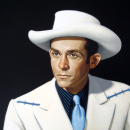
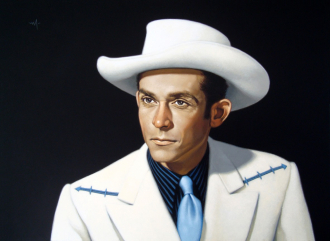
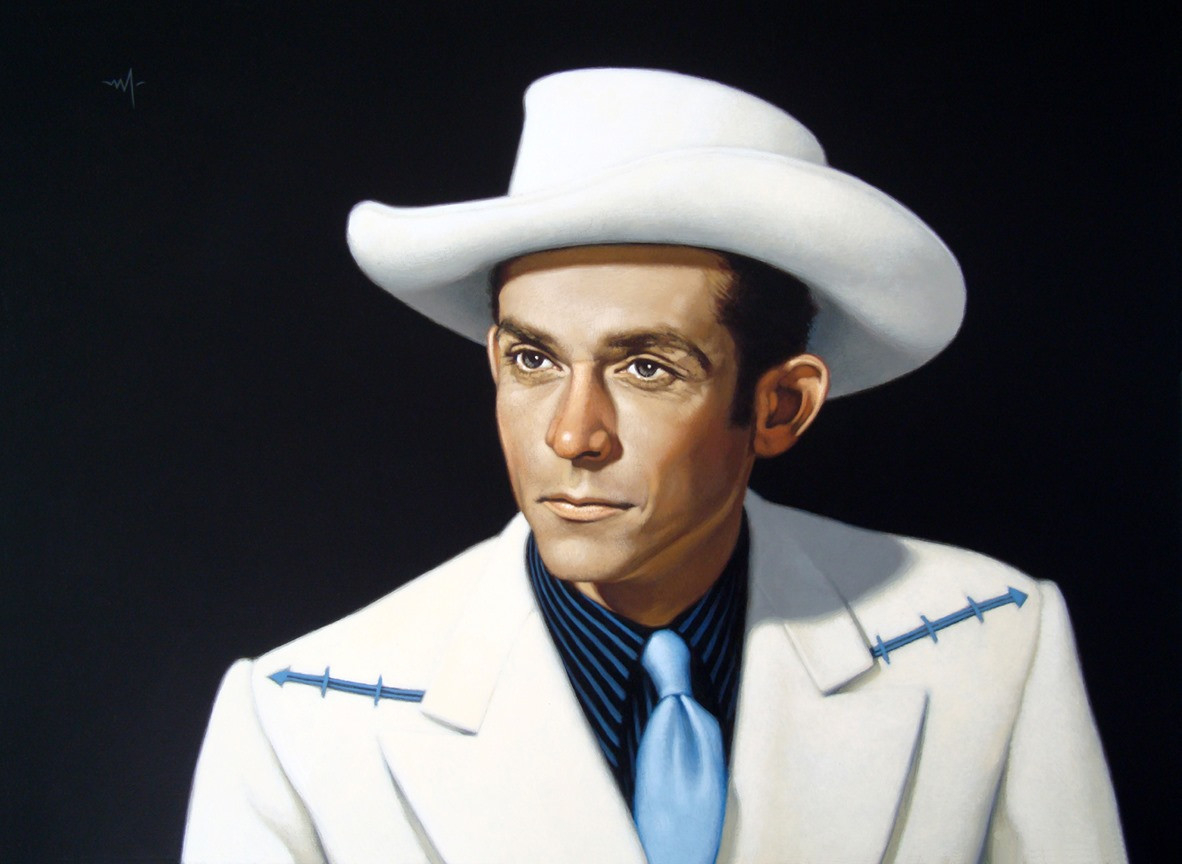
 Amanda S. Stevenson
Amanda S. Stevenson 